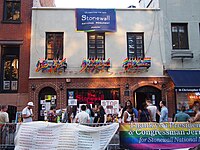
Photo from wikipedia
BACKGROUND AND OBJECTIVES Promoting age-friendliness of communities and supporting aging in place (AIP) are of great importance. Based on processes of belonging and agency, which suggest that person-environment interactions influence… Click to show full abstract
BACKGROUND AND OBJECTIVES Promoting age-friendliness of communities and supporting aging in place (AIP) are of great importance. Based on processes of belonging and agency, which suggest that person-environment interactions influence residents' evaluations and behaviors related to the environment, this study aims to examine the interrelationship between the availability of age-friendly features, perceived age-friendliness of community, and intention toward AIP. RESEARCH DESIGN AND METHODS This study used the 2015 AARP Age-Friendly Community Survey, which includes 66 home and neighborhood features under the eight domains specified by the WHO's Age-Friendly Cities Guidelines. A series of regression and mediational analyses were conducted to test hypotheses. RESULTS Overall, a greater availability of age-friendly features was positively associated with perceived age-friendliness of community and AIP intention. The relationship between age-friendly features and AIP intention was mediated by perceived age-friendliness of community (50.3% to 96% of the total effects). When perceived age-friendliness of community was introduced to models, the direct effects of housing, outdoor spaces and buildings, and transportation domains remained significant. DISCUSSION AND IMPLICATIONS Findings suggest that a greater availability of age-friendly features influences older adults' perception on their community, leading to the development of a desire to age-in-place, supporting processes of belonging and agency. Domains of housing, outdoor spaces and buildings, and transportation may be the most important features in promoting age-friendliness of community and the key determinants of aging in place. Policy makers and practitioners may need to prioritize promoting age-friendly built environment before social environment in building age-friendly communities.
Journal Title: The Gerontologist
Year Published: 2021
Link to full text (if available)
Share on Social Media: Sign Up to like & get
recommendations!